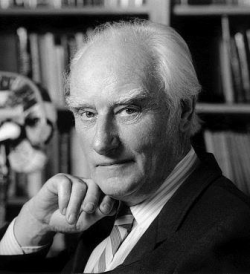Francis Crick

- Born
- 8 June 1916
- Died
- 28 July 2004 (age 88)
Francis Harry Compton Crick was born in 1916 in the then Northamptonshire village of Weston Favell, now part of Northampton. Crick’s grandfather, who passed away before Francis’s birth, was a naturalist and regularly corresponded with Charles Darwin. This may have influenced the young Crick, but his interest in science was encouraged by his uncle Walter who lived nearby and taught him simple chemical experiments and other skills such as blowing glass.
After showing promise at Northampton Grammar School, Crick won a scholarship at the age of 14 to the Mill Hill School in London, where he studied physics and chemistry, going on to win the school’s Walter Knox Prize for Chemistry. Crick stayed in London to gain his bachelors degree in physics at the University College London.
Despite being best known for his work in biology, he began to study for a PhD on the viscosity of water at high temperatures but this was interrupted by the advent of the second world war. During this period he worked at the Admiralty Research Laboratory where he worked extensively on the design of magnetic and acoustic mines.
Crick began to study biology in 1947, knowing almost nothing on the topics of organic chemistry or crystallography. He initially worked in Cambridge’s Strangeways Research Laboratory on the physical properties of cytoplasm, but later moved to the Cavendish Laboratory, also at Cambridge. In the late 1940s he worked extensively on x-ray crystallography and diffraction, which proved invaluable in pointing to the structure of DNA.
In 1951, Crick began to work with a young prodigy named James Watson. They co-published their model of a helical structure of DNA in 1953. Nine years later, Crick, Watson and Maurice Wilkins received the 1962 Nobel prize in Physiology or Medicine for the initial model and the subsequent refinements made, such as hypothesizing that the structure contained genetic information and also on the structure of viruses.
Their work gave rise to hundreds of possibilities, from vastly enhancing forensic investigations to genetic engineering and being able to identify and treat genetic disorders. It even allowed the development of cloning.
Crick died from colon cancer in July 2004. His legacy is still felt. Work on the Francis Crick Institute is due to be completed in 2015. This will become the largest biomedical research centre in Europe to find new ways to treat, diagnose and prevent illnesses such as cancer, heart disease, infections, and neurodegenerative diseases. The Institute will launch a PhD programme bearing his name and registered at his former university, University College London.
This profile was written by a Biology: Changing the World volunteer.



